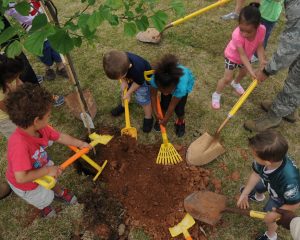Planting Trees to Improve Your Community
Benefits of Trees
Trees provide environmental and financial benefits, as well as benefits to human health. Environmentally, they provide habitats for wildlife, reduce runoff and erosion, store carbon, improve air quality, and naturally insulate. Financially, they increase property value and decrease spending on heating, cooling, and other energy costs. For human health, trees increase attention span, boost immune systems, improve mental health, decrease blood pressure, and decrease traffic accidents and pedestrian injuries.

How to Plant a Tree
- The first step in the tree planting process is asking why, where, and what. It is important that you evaluate both the space you want to plant the tree in and what you are hoping for from the tree. Some trees will provide more shade, some produce fruit, some need lots of sun and others tolerate shade well.
- Once you have decided on a type, it is time to pick out your specific tree! When you are at the nursery, look for a tree that has a straight leader (the tree’s central upright stem) to ensure it will grow straight. Also, look for branches that are evenly spaced and form an angle with the trunk that is between 45 and 60 degrees for maximum strength.
- Before you plant the tree, conduct a soil test to check the nutrient levels and a percolation test to check the drainage of the area. These two aspects will play a large role in the health of the tree throughout its entire life.
- After preparing the soil, it is time to dig. The hole for the tree should be saucer-shaped and three times as wide as the roots, but just deep enough that the roots are level with the ground. Once the tree has been placed in the ground, backfill the hole with the same dirt that was dug out, keeping the top of the roots exposed.
- Next, it is important to mulch the tree. Spread a layer of mulch that is 3-4 inches deep and 3 feet in diameter around the trunk leaving a small bare area around it. Do not pile the mulch up in a mound around the trunk of the tree!
- Some new trees require staking. If you plant a tree in a wide open area, a floodplain, or a windy spot it most likely needs to be staked.
For more details about each step and information about preparing the roots, watering, pruning, and trunk protection, take a look at the Neighborhood Tree Planting Guide!
The Inequality of Tree Canopy Cover
Trees have so many wonderful benefits, but unfortunately, these are not enjoyed equally by all Americans. Studies have shown that tree canopy cover, which is just the amount of cover trees have in an area, is much higher in affluent areas than in lower-income areas. You can experience this for yourself by driving around your own city and seeing if you notice a difference. This unfortunate reality can be changed, however, change begins with education. Check out this engaging New York Times article to learn more: “Since When Have Trees Existed Only for Rich Americans?“
